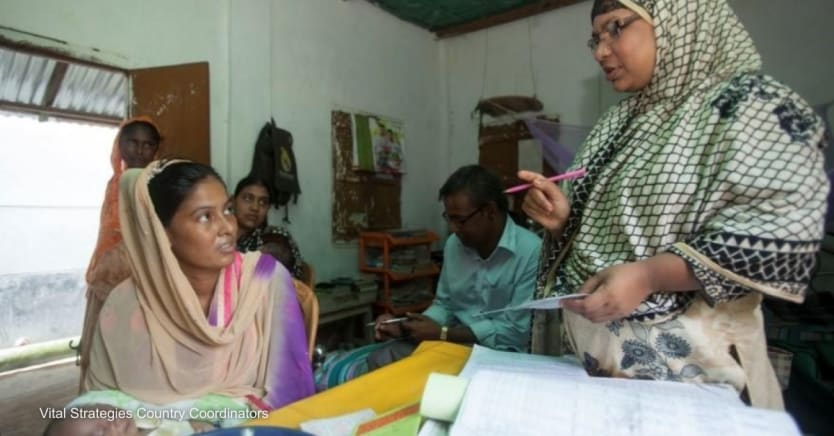
During the 10-day gathering of world leaders to review their promise to “leave no one behind,” the births of an estimated 955,000 babies across the globe were not — and likely will not be — registered.
Also, during that period, nearly 640,000 people likely died without their passing being officially recorded. While a record of one’s legal identity is taken for granted in many countries, millions of people around the world live and die without any such proof of existence — leaving them without access to a wide spectrum of individual rights, services, and protections. Those individuals, their family members, and their descendants are left very far behind.
With this year’s High-Level Political Forum on Sustainable Development grounded in the realities of COVID-19, it’s evident that we cannot move forward into a post-pandemic era without counting and accounting for all people everywhere. This month, the 76th session of the United Nations’ General Assembly provides another critical moment to make good on the promise of the 2030 Agenda for Sustainable Development to leave no one behind.
For individuals, official records of registered vital events — such as births, deaths, and marriage certificates — are crucial to unlocking social benefits such as education, health care, and the right to vote.
For governments, the information collected from registering these events provides insights into population health and needs not available from any other source. Yet 1 in 4 births — about 35 million — go unregistered every year, along with an estimated two-thirds of the nearly 60 million annual deaths worldwide. We can even clearly delineate regional disparities: 98% of deaths are registered in Europe while only 10% are registered in Africa.
If we want to truly leave no one behind, universal civil registration is fundamental. Leaders must strive to broaden the coverage of national systems to be more equitable and inclusive.
When civil registration reaches only a part of the population, it’s not only a plight for individuals — it’s a public health crisis. Without essential data about pressing public health challenges, governments instead rely on best guess methods to guide policy and program budgets.
The need for data on deaths, in particular regular outputs of a strong civil registration and vital statistics, or CRVS, system, has risen to the forefront during the COVID-19 era, as countries looked to excess mortality estimates to better understand and respond to the pandemic’s human toll. It became clearer than ever that a person who is uncounted is unseen in their country’s health and governance systems.
Sustainable Development Goals 16 and 17 set targets of 100% birth registration and 80% death registration by 2030, recognizing that a legal identity for all is a prerequisite for peaceful and inclusive societies. Having complete information helps governments paint a clear picture of population trends and causes of death in their countries, and guides decisions about how to direct resources to the most urgent challenges.
We know that with strong leadership and effective coordination, universal registration is possible. Failing to do so leaves millions of people without a foothold in services intended to serve everyone — hampering the success of priority programs such as universal health care.
More than 110 countries are still on the road to realizing coordinated, digitized CRVS systems that meet the goal of universal registration. The challenge is daunting — but not insurmountable.
New tools and technologies are enabling countries committed to counting everyone to reform and modernize their systems. That can start with revising the foundational legal framework for CRVS, which sometimes dates back to the colonial era and may exclude whole sectors of society.
Population and health information frameworks such as CRVS lay the foundation for a thriving health system. Dramatic improvements are possible when driven by political will.
—Next, countries must reimagine how the registration process itself can reach more of the population, namely by broadening access — removing barriers such as long distances to registration offices with limited office hours, and the potentially high financial investment involved. Last, is a look at policy and implementation, which involves ensuring vital statistics from registration data are analyzed by sex and geography to guarantee representation of everyone in the population.
Strengthening CRVS systems to meet the SDG targets will have an outsized impact in the many countries where there are still critically large gaps in data about women, children, and groups who exist outside the traditional reach of health care services.
Global progress on strengthening CRVS systems would have an immediate effect on 166 million children and more than 45% of women in low- and middle-income countries without legal proof of identity, opening up greater access to health and security at every point of their lives.
Efforts to strengthen systems require coordination across diverse sectors and stakeholders. Experience from the first six years of Bloomberg Philanthropies’ Data for Health initiative has demonstrated that scalable system improvements are rapidly more attainable than previously thought.
The main ingredients? Dynamic leadership, close coordination among the numerous agencies involved in CRVS, innovative technology, and the efforts of persistent champions at all levels of the system.
Counting every life is within reach. For example, by implementing an automated system for coding causes of death on medical death certificates, the Philippines Statistical Authority was able to process a digital backlog of over 1 million certificates in three years — and cut in half the time data becomes available for policy analysis.
Q&A: Estonia President Kaljulaid's global birth registration plans
Estonian President Kersti Kaljulaid, who is the new and first global advocate for Every Woman Every Child, discusses her priorities and the difference this role could make.
Smartphone apps that aid doctors in assigning the correct cause of death are now used in Sri Lanka and Brazil. Through the Kaliganj model currently being scaled in Bangladesh, front-line medical workers have been empowered to help families register births and deaths. In less than two years, in areas where it was first implemented, the model led to a tenfold increase in completeness of birth registration; death registration increased from 2% to 71% in two years.
Population and health information frameworks such as CRVS lay the foundation for a thriving health system. Dramatic improvements are possible when driven by political will.
The Kaliganj model, for example, began as a pilot in one subdistrict in Bangladesh and is now scaling to every district across the country, led by the Office of the Registrar General and three other national agencies focused on health, statistics, and justice, under the guidance of the prime minister’s office. This kind of seamless coordination removes roadblocks sometimes caused by competing priorities among different government entities.
CRVS is unique in its power to benefit every individual and inform public policy simultaneously. A strong system means that data on births, deaths, marriages, and more can be confidently and quickly translated into public policy on health, social welfare, and governance. It means that children across the globe can be protected from labor exploitation or underage marriage, that a widow is able to assert her inheritance rights, and that we can save lives by understanding what others cause of death.
Behind every SDG target and every vital statistic is a person, family, and community. As world leaders double down on their promise to leave no one behind, they must seize the opportunity to reach universal civil registration. If we are to build a truly more inclusive, equitable, and healthier world, we must ensure that everyone counts by counting everyone.








